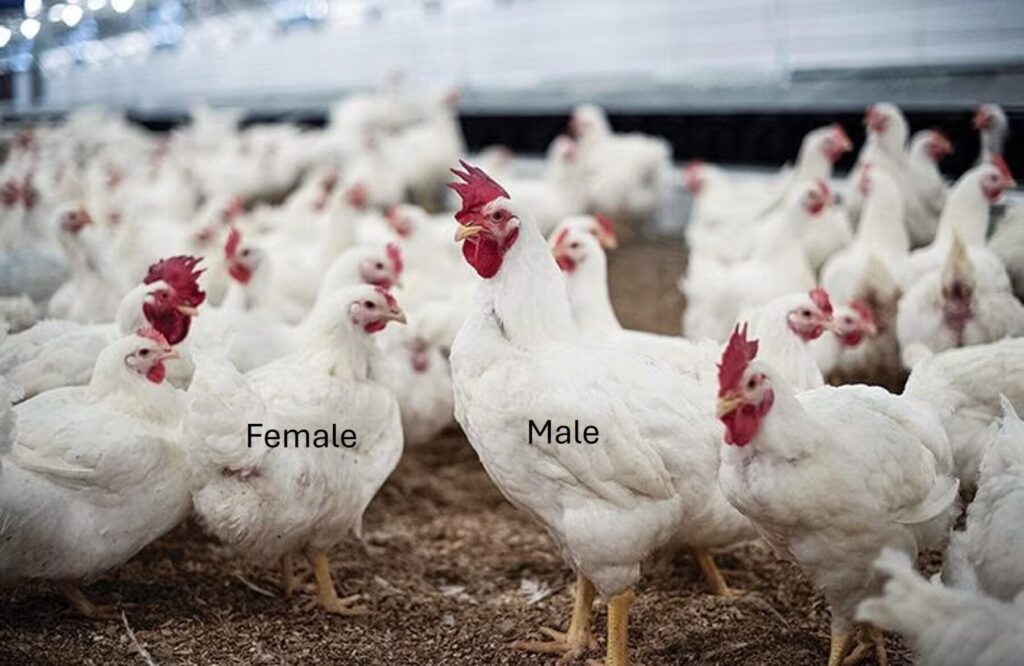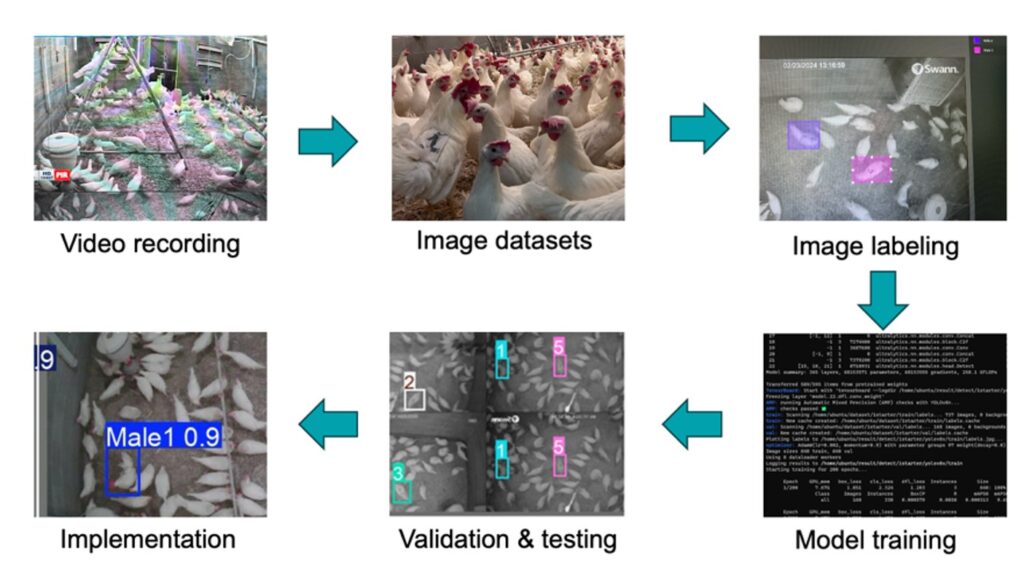Roosters’ behavior and activity are critical for egg fertility and hatchability in broiler or layer breeder houses. Desirable roosters are expected to have a good leg health, reach sexual maturity, be productive, and show less aggression to females during mating. However, not all roosters are desirable and low productive roosters should be removed for replacement. It’s challenging to monitor individual roosters for performance evaluation and behavior analysis in commercial broiler or layer breeder houses, where have up to thousands of chickens (Figure 1).

Figure 1. Male and female breeders in a breeding house (Photo Credit: Feed Strategy).
Researchers at the University of Georgia developed a new machine vision method by using deep learning models such as YOLO to detection all chickens on the floor and then detect male and female automatically in research cage-free poultry facilities (Figure 2 and Figure 3). Video datasets obtained from research facilities were converted into individual .jpg image files at a frame rate of 15 FPS using the Free Video to JPG Converter App (ver. 5.0). The resulting image datasets were manually filtered and stored based on the presence of at least one rooster in each image. The images were randomly selected for training, validation, and testing. A total of 100 chicken comb images and 2500 chicken body images were used to train the deep-learning models to quantify the differences between hens and roosters, where 70% of the images were used for training, 20% for validation, and 10% for testing. For hen and rooster detection based on comb size and rooster detection based on body size, image labeling was performed using the free website makesense.ai. Each image with hens and roosters was labeled with a bounding box of the corresponding hen’s comb as a hen and rooster’s comb as a rooster for hen and rooster detection based on comb size, while each image with roosters was labeled with a bounding box corresponding to each rooster number as Male1, Male2, Male3, Male4, Male5, and Male6 for roosters that were marked 1, 2, 3, 4, 5, and 6 to detect roosters based on body size. The workflow for hen and rooster detection based on comb size and rooster detection based on body size using both the YOLOv5u and YOLOv11 models is shown in (Figure 2).

Figure 2. Machine vision methods for automatic identification of six male chickens in a group with female chickens.
The training and validation prediction results of YOLOv5lu and YOLOv11x during hen and rooster detection based on comb size and YOLOv5xu and YOLOv11m during rooster detection based on body size are presented in Figure 3. For rooster detection based on comb size, YOLOv5lu, and YOLOv11x variants performed the best among the five variants of each model, with YOLOv5lu achieving a precision of 87.7%, recall of 56.3%, and mAP@0.50 of 60.1%, while YOLOv11x achieved a precision of 86.7%, recall of 65.3%, and mAP@0.50 of 61%. For rooster detection based on body size, YOLOv5xu, and YOLOv11m outperformed other variants, with YOLOv5xu achieving a precision of 88.9%, recall of 77.7%, and mAP@0.50 of 82.3%, while YOLOv11m achieved a precision of 89.0%, recall of 78.8%, and mAP@0.50 of 82.6%. This study provides a reference for automatic rooster monitoring based on comb and body size and offers further opportunities for tracking the activities of roosters in a poultry breeder farm for performance evaluation and genetic selection in the future.

Figure 3. Training and validation of prediction results of YOLOv5lu and YOLOv11x during the detection of hens and roosters. Where, (a) YOLOv5lu training, (b) YOLOv5lu validation, (c) YOLOv11x training, (d) YOLOv11x validation based on comb size, and (e) YOLOv5xu training, (f) YOLOv5xu validation, (g) YOLOv11m training, and (h) YOLOv11m validation based on body size.
This study focused on detecting hens and roosters based on comb size and rooster detection based on body size, using two machine learning models: YOLOv5u and YOLOv11. The research concluded that deep learning-based object detection models, especially YOLOv5lu and YOLOv11x, were effective in detecting hens and roosters based on comb size, while YOLOv5xu and YOLOv11m were effective in detecting roosters based on body size in a CF environment. Although the YOLOv11 models showed robust performance, earlier YOLOv5u models also performed competitively, indicating that newer versions are not always superior. Additionally, utilizing smaller models can reduce the training time and computational demands without compromising performance. This highlights the importance of selecting models based on specific needs and their performance requirements. These findings suggest that similar deep learning models could be applied in broiler and layer breeding programs to detect hens and roosters based on comb size as a first step towards precision rooster selection. Combining other features of roosters, such as body size, plumage condition, and body posture, could further increase the detection performance. The findings set a baseline for automated rooster detection and offer opportunities for performance evaluation and genetic selection in broiler and layer breeder farms.
Further reading:
Paneru, B., Bist, R. B., Yang, X., Dhungana, A., Dahal, S., & Chai, L*. (2025). Deep Learning Methods for Automatic Identification of Male and Female Chickens in a Cage-Free Flock. Animals, 15(13), 1862. https://doi.org/10.3390/ani15131862